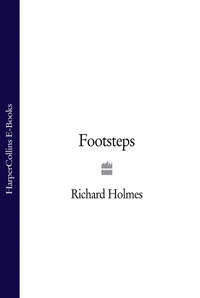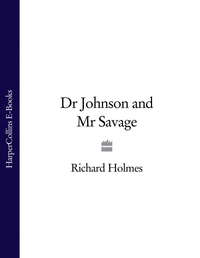
Полная версия
The Age of Wonder: How the Romantic Generation Discovered the Beauty and Terror of Science
As the men walked back, feeling dangerously like royalty, the Tahitian girls draped them with flowers, offered ‘all kind of civilities’ and gestured invitingly towards the coconut mats spread in the shade. Banks felt, reluctantly, that since islanders’ houses were ‘entirely without walls’ it was not quite the moment to ‘put their politeness to every test’. He would not have failed to have done so ‘had circumstances been more favourable’.4
2
Tahiti lies roughly east-west just below the 17th parallel, one of the largest of what are now the Society Islands, roughly halfway between Peru and Australia. It is shaped not unlike a figure of eight, some 120 miles (‘40 leagues’) in circumference. Most of its foreshores are easily accessible, a series of broad, curving bays with black volcanic sands or pinkish-white coral beaches, fringed by coconut palms and breadfruit trees. But a few hundred yards inland, the ground rises sharply into an entirely different topography. The steep, densely wooded volcanic hills lead upwards to a remote and hostile landscape of deep gullies, sheer cliffs and perilous ledges.
Contrary to legend, the Endeavour, commanded by Lieutenant James Cook, was not the first European ship to make landfall in Tahiti. Spanish expeditions, under Quiroz or Torres, had probably touched there in the late sixteenth century, and claimed it for Spain.5 A previous English expedition, under Captain Wallis of the Dolphin, had definitely landed there in 1767, when it was described as ‘romantic’, and claimed for England. A French expedition under Louis-Antoine de Bougainville had anchored there the following year, and claimed it for France.
The French had racily christened Tahiti ‘La Nouvelle Cythère’, the New Island of Love. Banks’s opposite number, the French botanist Philibert Commerson (who named the bougainvillea after his captain), had published a sensational letter in the Mercure de France describing Tahiti as a sexual ‘Utopia’. It proved that Jean-Jacques Rousseau was right about the existence of the Noble Savage. But then, the French had only spent nine days on the island.♣
Cook was more sceptical, and had every member of his crew (including the officers) examined for venereal infections four weeks before arriving, by their surgeon Jonathan Monkhouse. He issued a series of Landing Instructions, which stated that the first rule of conduct ashore was civilised behaviour: ‘To Endeavour by every fair means to cultivate a Friendship with the Natives and to treat them with all Imaginable Humanity.’6 It was no coincidence that he enshrined the ship’s own name in this instruction.
Joseph Banks had his own views on Paradise. He gave a whimsical account of his first night ashore in his Endeavour Journal. He dined deliciously on dressed fish and breadfruit, next to a Tahitian queen, who ‘did me the honour with very little invitation to squat down on the mats close by me’. However, the queen was ‘ugly enough in conscience’. Banks then noticed a very pretty girl, ‘with a fire in her eyes’ and white hibiscus in her hair, lingering in the ‘common crowd’ at the door. He encouraged her to come and sit on his other side, studiously ignored the queen for the rest of the evening, and ‘loaded’ the Polynesian beauty with bead necklaces and every compliment he could manage. ‘How this would have ended is hard to say,’ he observed later. In fact the amorous party broke up abruptly when it was discovered that his friend Solander had had a snuffbox picked from his pocket, and a fellow officer had lost ‘a pair of opera glasses’. It is not explained why he had brought opera glasses ashore in the first place.
This thieving proved to be completely customary in Tahiti, and led to many painful misunderstandings on both sides. The first occurred the following day, when a Tahitian quite openly made off with a marine’s musket, and was immediately shot dead by a punctilious guard. Banks quickly grasped that some quite different notion of property must be involved, and noted grimly: ‘We retird to the ship not well pleased with the days expedition, guilty no doubt in some measure of the death of a man who the most severe laws of equity would not have condemnd to so severe a punishment. No canoes about the ship this morning, indeed we could not expect any as it is probable that the news of our behaviour yesterday was now known every where, a circumstance which will doubtless not increase the confidence of our friends the Indians.’ Nonetheless, to Banks’s relief and evident surprise, good relations were restored within twenty-four hours.
The Endeavour expedition remained for three months on Tahiti. Its main object was to observe a Transit of Venus across the face of the sun. (Cook stated that this was the reason their settlement was named Fort Venus, though his junior officers gave a different explanation.) This was due on the morning of 3 June 1769, and there would be no other transit for the next hundred years (not until 1874). It was a unique chance to establish the solar parallax, and hence the distance of the sun from the earth. This calculation depended on observing the exact timing at which the silhouette of Venus first entered, and then exited from, the sun’s disc.
Banks was not part of the astronomical team, but when the expedition’s quadrant was stolen one night shortly before the transit was due, he reacted with characteristic energy and courage. He knew that without this large and exquisitely calibrated brass instrument, used to measure precise astronomical angles, the entire observation would be rendered valueless. Not waiting for Cook or his marine guards, Banks roused the expedition’s official astronomer, William Green, and set off immediately on foot in pursuit of the thief. In the dizzy heat, Banks followed the trail far up into the hills, accompanied only by a reluctant Green, one unarmed midshipman and a Tahitian interpreter. They penetrated seven miles inland through the Tahitian jungle, further than any European had been before: ‘The weather was excessive hot, the Thermometer before we left the tents up at 91 made our journey very tiresome. Sometimes we walk’d sometimes we ran when we imagind (which we sometimes did) that the chase was just before us till we arrived at the top of a hill about 4 miles from the tents. From this place [the interpreter] Tubourai shew’d us a point about 3 miles off and made us understand that we were not to expect the instrument till we got there. We now considerd our situation. No arms among us but a pair of pocket pistols which I always carried; going at least 7 miles from our fort where the Indians might not be quite so submissive as at home; going also to take from them a prize for which they had ventured their lives.’7
Banks decided to send back the midshipman with a brief message to Cook that armed reinforcements would be welcome. Meanwhile he and Green would press on alone, ‘telling him at the same time that it was impossible we could return till dark night’.
Before dusk, Banks ran the thief to ground in an unknown and potentially hostile village. A crowd quickly gathered round them, ‘rudely’ jostling them. Following a Tahitian custom he had already learned, Banks quickly drew out a ring on the grass, and surrounded by ‘some hundreds’ of faces, sat quietly down in the centre. Here, instead of threatening or blustering, he began to explain and negotiate. For some time nothing transpired. Then, piece by piece, starting with its heavy wooden deal case, the quadrant was solemnly returned. ‘Mr Green began to overlook the Instrument to see if any part or parts were wanting…The stand was not there but that we were informed had been left behind by the thief and we should have it on our return…Nothing else was wanting but what could easily be repaired, so we pack’d all up in grass as well as we could and proceeded homewards.’
By the time armed marines came up, sweating and jittery, about two miles down the track, Banks had completed the transaction and made several new friends. Everyone returned peacefully to Fort Venus on the shore. For this exploit, all conducted with the greatest calm and good humour, Banks earned the profound gratitude of Cook, who noted that ‘Mr Banks is always very alert upon all occasions wherein the Natives are concerned.’8 Banks concluded mildly in his journal: ‘All were, you may imagine, not a little pleased at the event of our excursion.’9
Banks and Cook were a seemingly ill-matched pair. They were divided by background, education, class and manners. Yet they formed a curiously effective team. Cook’s cool and formal manners towards the Tahitians were balanced by Banks’s natural openness and enthusiasm, which easily won friends. With their help he would gather a mass of plant and animal specimens, and make what was in effect an early anthropological study of Tahitian customs. His journal entries cover everything from clothes (or lack of them) and cookery to dancing, tattooing, sexual practices, fishing methods, wood-carving, and religious beliefs. His accounts of a dog being roasted, or a young woman having her buttocks tattooed, are frank and unforgettable. He attended Tahitian ceremonial events, slept in their huts, ate their food, recorded their customs and learned their language. He was pioneering a new kind of science. As he wrote in his journal: ‘I found them to be a people so free from deceit that I trusted myself among them almost as freely as I could do in my own countrey, sleeping continually in their houses in the woods with not so much as a single companion.’10
3
Educated in the traditional classics at Harrow, Eton and Christ Church, Oxford, young Joseph Banks had discovered science and the natural world at the age of fourteen. Towards the end of his life he told a sort of ‘conversion’ story about this to his friend the surgeon Sir Everard Home. It was later enshrined by the French naturalist Georges Cuvier in his obituary speech or Éloge to the Institut de France. Emerging late one summer afternoon from a schoolboy swim in the Thames at Eton, the teenage Banks found himself alone on the river, all his schoolfriends gone. Walking back through the green lanes, solitary and preoccupied, he suddenly saw the mass of wildflowers along the hedgerows vividly illuminated in the slanting, golden evening light. Their beauty and strangeness came to him like a revelation. ‘After some reflection, he said to himself, it is surely more natural that I should be taught to know all the productions of Nature, in preference to Greek and Latin; but the latter is my father’s command and it is my duty to obey him…He began immediately to teach himself Botany.’
Despite the stilted form of this recollection (it is in Home’s words and dates from fifty years after the event), it seems that to the young Banks botany implied a kind of Romantic rebellion against his father, as well as against the standard school curriculum of classics. Even more important, it brought him into contact with a race of people who would normally have been quite invisible to a privileged Eton schoolboy such as he. These were the wise women of the country lanes and hedgerows, the gypsy herbalists who collected ‘simples’ or medicinal plants ‘to supply the Druggist and Apothecaries shops’ of Windsor and Slough. They were a strange but knowledgeable tribe, whom he soon learned to treat with respect. More than that, he paid them sixpence for every ‘material piece of information’ they supplied.
Banks also told Everard Home that it was his mother-not his father-who handed over her lovingly worn copy of Gerard’s Herbal, kept ‘in her dressing room’, with wonderful engravings that entranced him. It is thus that he is shown in a family portrait (possibly by Zoffany): an attractively long-haired and long-legged teenager, alert and faintly insolent, confidently posed in a studded leather chair with a portfolio of botanical engravings spread before him. Just under his left elbow, extraordinarily prophetic, is a large geographer’s globe in its mahogany cradle, with a rhumb-line of sunlight curving down towards the equator.
From then on Banks saw his destiny as a naturalist, and began avidly collecting rare plants, wildflowers, herbs, shells, stones, animals, insects, fish and fossils. His conversion story reveals other elements of his life and character: self-confidence, wealth, surprising sensitivity, unconventional directness, and an attraction to women. At university he made himself a disciple of the great Swedish naturalist Carl Linnaeus, the leading Enlightenment botanist of Europe. Linnaeus had redefined the taxonomy of plants by identifying them according to their reproductive organs, re-cataloguing them in Latin according to genus, species and family, and collecting an unmatched array of specimens in his gardens at Uppsala.
Finding that there was no Linnaean lecturer in botany at Oxford, Banks reacted in a characteristic way. He rode to Cambridge, begged an interview with the Professor of Botany there, John Martyn, and simply asked to be recommended the best young botanist available. He came back triumphantly with a gifted young Jewish botanist, Israel Lyons, who had agreed to teach the subject to Banks and a group of like-minded undergraduates at Oxford. Banks paid Lyons a good salary out of his own pocket. Later he recommended him to an Admiralty expedition, and he remained his friend and patron for life. Lyons was Banks’s first scientific protégé. From the start Banks displayed the commanding air, as well as the charm, of a wealthy man. This trait was given free rein when his father died in 1761. At the age of eighteen he was now sole heir to large estates in Lincolnshire and Yorkshire (they included over 200 farms) which would bring him £6,000 per annum (eventually rising to over £30,000), an enormous income for the period.
The family money made Banks a complete gentleman of leisure, a potentially fatal development, and he moved with his beloved mother and his only sister, Sophia, to a large house in Chelsea, near the Physic Garden. The conventional thing would have been for him to embark, like most of his friends, on the Grand Tour of Europe. Instead, the twenty-two-year-old Banks bought himself a berth on HMS Niger, and embarked on a strenuous seven-month botanical tour to the bleak shores of Labrador and Newfoundland. The Professor of Botany at Edinburgh wrote to him with some astonishment that it was ‘rumoured that you was going to the country of the Eskimaux Indians to gratify your taste for Natural Knowledge’.
Banks demonstrated his energy and commitment on this expedition, earning the approval of all the naval officers, including his friend Captain Constantine John Phipps, and a certain Lieutenant James Cook, who was in charge of chart-making. He wrote witty, faintly scurrilous letters to his sister Sophia, and also kept the first of his great journals, most notable for their racy style, appalling spelling and non-existent punctuation. On his return in November 1766, with a vast quantity of plant specimens (and some caoutchouc from Portugal), Banks was elected a Fellow of the Royal Society, still aged only twenty-three. He began what was to become his famous herbarium, scientific library and collection of prints and drawings. His rapidly expanding circle of scientific friends included the rakish Lord Sandwich, future head of the Admiralty, and the quiet, portly and dedicated Daniel Solander, a young Swedish botanist, trained under Linnaeus at Uppsala, who managed the Natural History section of the British Museum.
Two years later, Banks heard of the round-the-world expedition in HM Bark Endeavour. The ship was in fact a specially converted coastal ‘cat’ from Whitby, broad-beamed, shallow-draughted and immensely strong, capable of being beached for repairs, and of carrying large quantities of stores and livestock below decks (and on them). But she was little more than a hundred feet from stem to stern, and had extremely restricted quarters. She was to be commanded by Lieutenant James Cook, forty years old, lean and reserved, the tough and experienced mariner from the little port of Staithes in Yorkshire who had made his name charting the Newfoundland coast.
The expedition was organised by the Admiralty, but also partly financed by the Royal Society, which supplied £4,000 towards astronomical observations. It had four main objectives: first, the observing of the Transit of Venus on Tahiti; second, charting and exploring the Polynesian islands west of Cape Horn; third, exploring the landmasses known to lie between the 30th and 40th parallels-New Zealand (possibly the tip of a continent) and Van Diemen’s Land (Tasmania), possibly part of Australia; and fourth, collecting botanical and zoological specimens from anywhere in the southern hemisphere. It also had a medical aim, to reduce the fatal outbreaks of shipboard scurvy by the use of sauerkraut and citrus fruits.
The Royal Society had already appointed as the expedition’s official astronomer William Green, assistant to the Astronomer Royal, Nevil Maskelyne. Banks immediately proposed himself as its official botanist. He would finance his own eight-man natural history ‘suite’, including two artists, a scientific secretary, Herman Spöring, two black servants from the Yorkshire estate, his friend Dr Solander and-characteristically-a pair of greyhounds. For these, and a mass of equipment, Banks laid out as much as £10,000, nearly two years’ income. For him it was to be a voyage in search of pure knowledge, and he laid in specialist equipment which created a considerable stir. A colleague reported admiringly, and with perhaps a touch of envy, to Linnaeus in Uppsala: ‘No people ever went to sea better fitted out for the purpose of Natural History; nor more elegantly. They have got a fine library of Natural History; they have all sorts of machines for catching and preserving insects; all kinds of nets, trawls, drags and hooks for coral fishing; they have even a curious contrivance of a telescope by which, put into water, you can see the bottom at a great depth.’ He concluded reassuringly to Linnaeus: ‘All this is owing to you and your writings.’11
But there was, of course, an element of imperial competition. Cook had sealed Admiralty instructions to look out, after leaving Tahiti, for a possible ‘great Southern continent’ lying between latitude 30 and 40 degrees South. This was much further south than those parts of Australia’s eastern seaboard which were already known through the Dutch navigators. It was believed that New Zealand might form the northern tip to this continent, and that it might contain huge natural resources. If this continent existed, it had to be claimed and mapped (with a view to possible colonisation) before the French did so. The Admiralty seems to have been unaware of Antarctica.
The imperial instructions were not really so secret. Both Banks and Solander knew about them before departure, and even Linnaeus was informed.12 Moreover, neither Banks nor Cook really believed in the mysterious southern continent. Banks made a long, sceptical journal entry as they crossed the Pacific in March 1769, concluding: ‘It is however some pleasure to be able to disprove that which does not exist but in the opinions of Theoretical writers, of which sort most are who have wrote any thing about these seas without having themselves been in them. They have generaly supposed that every foot of sea which they beleived no ship had passed over to be land, tho they had little or nothing to support that opinion but vague reports…’ Nevertheless, he was fully aware of how little was known about the Pacific islands in general, and of the perils of circumnavigation, especially between Tahiti and Indonesia. It had nearly destroyed Bougainville’s entire crew the year before.
Among the many friends Banks was leaving behind was Solander’s colleague the botanist and horticulturalist James Lee, who took an intense professional interest in the Pacific voyage. Lee owned the remarkable Vineyard Nurseries at the village of Hammersmith on the Thames. He was the author of a best-selling plant manual, An Introduction to Botany extracted from the works of Dr Linnaeus (1760), which ran into several editions, and he advised Banks on plant-collecting. Lee also trained up young naturalists at the nurseries. Among his assistants was an eighteen-year-old Scottish Quaker, Sydney Parkinson, a quiet, observant young man, whom Banks decided to employ as his second botanical artist aboard the Endeavour. It was a good choice, but with tragic consequences.
Another young person in Lee’s charge was twenty-year-old Harriet Blosset, to whom he was legal guardian. Lee was teaching her to study plants, and she would eagerly have signed up for the expedition herself. But of course no women were officially allowed on board His Majesty’s vessels, although the French botanist Philibert Commerson had smuggled his mistress aboard Bougainville’s ship, disguised as a cabin boy. It was rumoured at the nurseries that Harriet was ‘desperately in love with Mr Banks’, and there was a good deal of gossip about them immediately before the expedition’s departure.13 A fellow botanist, Robert Thornton, extravagantly catalogued Harriet as a young lady who ‘possessed extraordinary beauty, and every accomplishment, with a fortune of ten thousand pounds. Mr Banks had often seen her, when visiting the rare plants of Lee’s, and thought her the fairest among the flowers.’14
In fact Harriet was one of three sisters who lived with their widowed mother in Holborn. Banks does seem to have been genuinely fond of her, and subsequent events suggest there was some kind of understanding between them. Her guardian James Lee looked upon it as an unofficial engagement, which would be announced if Banks should return alive from the Pacific. There was also some joke about Harriet knitting a set of ‘worked’ waistcoats for Banks while he was away, patterned with wildflowers-perhaps one for each season he was absent.15
Yet Banks was certainly cautious about marriage at this stage in his career, remarking drily to a friend that though he loved experiments, matrimony was ‘an experiment…with uncertain consequences’, and rarely brought lifelong happiness. The eve of his great voyage was certainly not the moment to try it.16 In a rare introspective entry Banks would reflect in his journal that he would probably never see Europe again, and that there were only two people in the world who would truly miss him. ‘Today for the first time we dined in Africa, and took our leave of Europe for heaven alone knows how long, perhaps for Ever; that thought demands a sigh as a tribute due to the memory of freinds left behind and they have it; but two cannot be spared, t’would give more pain to the sigher, than pleasure to those sighd for. Tis Enough that they are rememberd, they would not wish to be too much thought of by one so long to be seperated from them and left alone to the Mercy of winds and waves.’17
If these two were his mother and his sister Sophia, then he did not wish to sigh unduly for Harriet Blosset. A certain bluffness was in order. When asked why he did not settle for the security of the eighteenth-century Grand Tour, the object of which as Dr Johnson said was to visit the classical civilisations along the shores of the Mediterranean, he replied briskly: ‘Every blockhead does that; my Grand Tour shall be one round the whole Globe.’18
Banks spent his last night before going aboard at the opera. Then he dined in company with Harriet Blosset at her mother’s house, accompanied by a Swiss geologist, Horace de Saussure, who assumed from their behaviour that they were ‘betrothed’. Saussure described Harriet as very pretty and attentive, but ‘a prudent coquette’, and Banks as quite reconciled to their imminent parting, and drinking rather too much champagne.19
When the naturalist Gilbert White, snug in his Hampshire village, heard of Banks’s departure on the high seas, he wrote thoughtfully to their mutual friend Thomas Pennant: ‘When I reflect on the youth and affluence of this enterprizing young gentleman I am filled with wonder to see how conspicuously the contempt of dangers, and the love of excelling in his favourite studies, stands forth in his character…If he survives, with what delight we shall peruse his Journals, his Fauna, his Flora! If he falls by the way, I shall revere his fortitude, and contempt of pleasures and indulgences: but shall always regret him.’20











